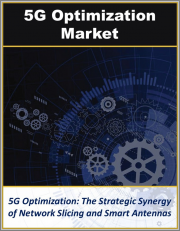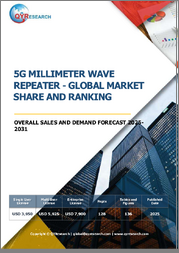
|
시장보고서
상품코드
1822330
세계의 자동 제조용 5G와 커넥티비티 시장 예측(-2032년) : 컴포넌트별, 배포 유형별, 기업 규모별, 커넥티비티 유형별, 기술 통합별, 최종사용자별, 지역별 세계 분석5G and Connectivity in Automated Manufacturing Market Forecasts to 2032 - Global Analysis By Component (Hardware, Software and Services), Deployment Type, Enterprise Size, Connectivity Type, Technology Integration, End User and By Geography |
||||||
Stratistics MRC에 따르면 세계의 자동 제조용 5G와 커넥티비티 시장은 2025년에 100억 3,000만 달러를 차지하며 예측 기간 중 CAGR은 7.4%로 성장하며, 2032년에는 165억 3,000만 달러에 달할 것으로 예측됩니다.
5G는 산업 환경 내에서 빠르고 안정적인 초저지연 통신을 제공함으로써 자동제조업에 혁명을 불러일으키고 있습니다. 5G는 대규모 기기 연결을 지원하고 기계, 로봇, IoT 센서 간의 원활한 상호 작용을 가능하게 하여 실시간 인사이트와 예측 분석을 가능하게 합니다. 이를 통해 제조업체는 효율성을 높이고, 다운타임을 최소화하며, 공급망 프로세스를 간소화할 수 있습니다. 더 빠른 데이터 전송으로 AI, 디지털 트윈, 자동화 시스템 등의 기술이 더 실용적이고 효과적일 수 있습니다. 또한 5G는 원격 조작, 유연한 생산 레이아웃, 스마트한 공장 운영을 가능하게 합니다. 인더스트리 4.0의 중추 역할을 하는 5G는 현대 제조 생태계의 생산성 향상, 적응성, 강력한 연결성을 보장합니다.
5G Technology World에 따르면 공공 5G 네트워크에서 실제 측정한 결과, 100kb/s의 데이터 속도에서 하향 링크의 OWL(One-way Latency)은 7밀리초로 낮게 나타났다고 합니다.
스마트 팩토리에 대한 수요 증가
스마트 팩토리의 확대는 자동화된 제조 분야에서 5G와 커넥티비티의 필요성을 더욱 가속화시키고 있습니다. 이러한 첨단 설비는 IoT 기반 장치, 지능형 로봇 공학, 지속적인 데이터 흐름에 의존하며, 신뢰할 수 있는 고속 통신 네트워크가 필요합니다. 5G는 고급 모니터링 시스템, 자동화 툴, 실시간 분석을 통합하는 데 필요한 인프라를 제공합니다. 기업은 생산성 향상, 운영 리스크 감소, 유연하고 확장 가능한 제조 라인의 도입을 위해 점점 더 많은 기업이 운영 현대화를 추진하고 있습니다. 5G는 일관된 연결성과 적응성을 제공함으로써 산업계가 고객의 요구와 변화하는 시장 역학에 신속하게 대응할 수 있게 해줍니다. 이처럼 보다 스마트하고 상호 연결된 제조 공정에 대한 강력한 수요가 연결성 시장의 성장을 촉진하고 있습니다.
높은 도입 비용
5G 인프라 도입에 따른 막대한 비용이 자동화 제조에 큰 걸림돌로 작용하고 있습니다. 5G를 구축하려면 고급 네트워크 하드웨어, 호환 가능한 소프트웨어, 시스템 업그레이드에 많은 투자를 해야 하는데, 예산이 한정된 중소기업에게는 어려움이 따릅니다. 또한 새로운 5G 기술을 기존 레거시 장비에 통합해야 하는 과제는 비용을 더욱 증가시킬 수 있습니다. 제조업체들은 재무적 매출이 불투명할 경우 채택을 늦추거나 제한하는 경우가 많습니다. 프라이빗 네트워크 구축과 운영 연속성 유지를 위해 더 많은 비용을 지출해야 합니다. 이러한 높은 재정적 수요는 대규모 통합을 제한하고, 도입 비용은 산업 운영에서 5G의 신속한 채택을 방해하는 주요 장벽 중 하나입니다.
스마트 팩토리와 인더스트리 4.0의 성장
인더스트리 4.0 구상의 가속화와 스마트 팩토리의 부상으로 자동화 제조 분야에서 5G 도입의 큰 기회가 열리고 있습니다. 이러한 최신 생산 환경은 유연성과 생산성을 높이기 위해 상호 연결된 시스템, 지능형 로봇 공학, 센서 기반 데이터에 의존하고 있습니다. 5G의 초신뢰성 연결성, 대용량 장치, 고속 데이터 전송은 이러한 시스템의 이상적인 원동력이 될 수 있습니다. 5G는 실시간 분석, AI 용도, 가상 시뮬레이션을 지원함으로써 제조업체의 운영 민첩성과 생산성을 향상시킬 수 있습니다. 전 세계 기업이 디지털 제조 전략으로 전환하는 가운데, 인더스트리 4.0으로의 전환은 산업 생산 프레임워크 내에서 첨단 5G 솔루션을 구축할 수 있는 엄청난 기회를 보장합니다.
급속한 기술적 노후화
자동화 제조 산업에서 5G 도입의 심각한 위협 중 하나는 기술이 빠르게 노후화될 위험입니다. 기술 혁신의 속도가 빠르기 때문에 기업이 투자 비용을 회수하기도 전에 시스템이나 장비가 관련성을 잃을 수 있습니다. 이 때문에 잦은 업그레이드와 통합의 장애물, 비용 증가를 두려워하는 제조업체들이 주저하게 됩니다. 끊임없는 발전은 산업 운영의 장기적인 안정성을 보장하기 어렵게 만듭니다. 새로운 표준에 적응하지 못하는 조직은 업무의 비효율성과 경쟁력 하락에 직면할 수 있습니다. 비용과 복잡성이라는 압박은 미래의 제조 전략을 위해 5G 연결에 투자하는 기업에게 큰 위협이 될 수 있습니다.
COVID-19의 영향:
COVID-19는 자동 제조 산업에서 5G와 연결성의 성장에 큰 영향을 미쳤습니다. 전 세계적인 봉쇄, 공급망 단절, 노동력 부족으로 인해 자동화와 원격 기능의 필요성이 강조되었습니다. 기업은 업무 연속성을 유지하는 데 있으며, 초고속 보안 연결성이 중요한 역할을 한다는 것을 점점 더 많이 인식하고 있습니다. 처음에는 재정적 문제로 인해 기술 투자가 늦어졌지만, 위기는 디지털화와 인더스트리 4.0으로의 전환을 가속화했습니다. 5G를 활용한 IoT, 로보틱스, 애널리틱스의 도입은 제조업체들이 회복력과 적응성을 추구하면서 더욱 탄력을 받고 있습니다. 결국, 팬데믹은 전 세계에서 유연하고 효율적이며 미래지향적인 제조 공정을 지원하는 5G의 가치를 강조하는 전환점이 되었습니다.
예측 기간 중 하드웨어 부문이 가장 클 것으로 예측됩니다.
하드웨어 부문은 원활한 운영을 위한 핵심 인프라를 제공하므로 예측 기간 중 가장 큰 시장 점유율을 차지할 것으로 예측됩니다. 기지국, 안테나, 라우터, 산업용 센서와 같은 핵심 구성 요소는 생산 시설 내에서 초고속, 저지연 통신을 지원하기 위한 기본입니다. 이러한 요소들은 기계, 로봇, IoT 시스템이 원활하게 상호 작용하여 효율성과 정확성을 향상시킵니다. 자동화 및 인더스트리 4.0에 대한 관심이 높아지면서 견고한 하드웨어 솔루션에 대한 수요는 지속적으로 증가하고 있습니다. 하드웨어 부문은 스마트 기술을 통합하는 기반으로서 차세대 커넥티드 제조 생태계를 추진하는 데 있으며, 하드웨어 부문이 주도적인 역할을 하고 있습니다.
AI/ML 통합 부문은 예측 기간 중 가장 높은 CAGR을 보일 것으로 예측됩니다.
예측 기간 중 AI/ML 통합 부문이 가장 높은 성장률을 보일 것으로 예측됩니다. 5G의 높은 대역폭과 초저지연성을 활용하여 AI와 머신러닝은 산업 데이터의 연속적인 스트림을 신속하게 분석하여 실용적인 인사이트를 제공할 수 있습니다. 이를 통해 예측 분석, 효율적인 품질관리, 생산 시스템 전반에 걸친 민첩한 의사결정을 지원합니다. AI/ML은 다운타임을 줄이고 정확도를 향상시킴으로써 스마트 팩토리의 생산성과 유연성을 크게 향상시킬 수 있습니다. 그 적용 범위는 공급망 최적화, 에너지 사용 관리, 복잡한 프로세스의 자동화에 이르기까지 다양합니다. 5G 커넥티비티와 AI/ML의 강력한 조합은 이 부문이 향후 가장 강력하게 확장될 것임을 보장합니다.
최대 점유율 지역:
예측 기간 중 북미는 강력한 디지털 인프라와 첨단 기술의 조기 도입으로 인해 가장 큰 시장 점유율을 차지할 것으로 예측됩니다. 이 지역은 5G 구축의 최전선에 있으며, 산업계가 스마트팩토리를 빠르게 도입할 수 있도록 돕고 있습니다. 자동차, 항공우주, 전자 등 다양한 분야의 기업은 자동화, 실시간 모니터링, 효율성 향상을 위해 5G를 탑재한 시스템을 활용하고 있습니다. 산업 현대화를 촉진하는 유리한 정책과 함께 막대한 투자가 성장을 더욱 촉진하고 있습니다. 또한 기술 공급자와 제조업체 간의 파트너십은 대규모 배포를 가속화합니다. 혁신 생태계가 잘 구축된 북미는 커넥티드 제조 솔루션의 세계 최대 시장 점유율을 확보하고 있습니다.
CAGR이 가장 높은 지역:
예측 기간 중 아시아태평양이 가장 높은 CAGR을 보일 것으로 예측됩니다. 강력한 산업 확장과 스마트 기술 채택의 가속화가 이 모멘텀을 촉진하고 있습니다. 중국, 일본, 한국, 인도 등의 국가들은 5G 네트워크와 자동화 개념에 대한 투자를 우선시하고 있습니다. 인더스트리 4.0을 촉진하는 정부 지원 프로그램, 주요 자동차 및 전자제품 제조 기지의 존재와 함께 성장 전망을 높이고 있습니다. 또한 저렴한 노동력, 빠른 기술 개발, 대규모 산업 현대화가 채택을 촉진하고 있습니다. 그 결과, 아시아태평양은 가장 높은 성장률을 보이는 지역으로, 5G 대응 솔루션을 통해 미래의 제조업을 재구성할 것입니다.
무료 커스터마이징 서비스:
이 보고서를 구독하는 고객은 다음과 같은 무료 맞춤화 옵션 중 하나를 이용할 수 있습니다.
- 기업소개
- 추가 시장 기업 종합 프로파일링(최대 3사)
- 주요 기업의 SWOT 분석(최대 3사)
- 지역 세분화
- 고객의 관심에 따른 주요 국가별 시장 추정, 예측, CAGR(주: 타당성 확인에 따라 다름)
- 경쟁사 벤치마킹
- 제품 포트폴리오, 지역적 입지, 전략적 제휴를 기반으로 한 주요 기업 벤치마킹
목차
제1장 개요
제2장 서문
- 개요
- 이해관계자
- 조사 범위
- 조사 방법
- 데이터 마이닝
- 데이터 분석
- 데이터 검증
- 조사 어프로치
- 조사 자료
- 1차 조사 자료
- 2차 조사 자료
- 전제조건
제3장 시장 동향 분석
- 촉진요인
- 억제요인
- 기회
- 위협
- 기술 분석
- 최종사용자 분석
- 신흥 시장
- COVID-19의 영향
제4장 Porters Five Force 분석
- 공급 기업의 교섭력
- 바이어의 교섭력
- 대체품의 위협
- 신규 진출업체의 위협
- 경쟁 기업 간 경쟁 관계
제5장 세계의 자동 제조용 5G와 커넥티비티 시장 : 컴포넌트별
- 하드웨어
- 소프트웨어
- 서비스
제6장 세계의 자동 제조용 5G와 커넥티비티 시장 : 배포 유형별
- 퍼블릭 5G 네트워크
- 프라이빗 5G 네트워크
- 하이브리드 네트워크
제7장 세계의 자동 제조용 5G와 커넥티비티 시장 : 기업 규모별
- 대기업
- 중소기업
제8장 세계의 자동 제조용 5G와 커넥티비티 시장 : 커넥티비티 유형별
- 대규모 IoT
- 중요한 IoT
- 산업 자동화 IoT
- 방송 IoT
제9장 세계의 자동 제조용 5G와 커넥티비티 시장 : 기술 통합별
- 엣지 컴퓨팅
- AI/ML통합
- AR/VR 애플리케이션
- 디지털 트윈 시스템
제10장 세계의 자동 제조용 5G와 커넥티비티 시장 : 최종사용자별
- 자동차
- 일렉트로닉스
- 의약품
- 식품 및 음료
- 중기
- 섬유·의류
- 물류·창고
제11장 세계의 자동 제조용 5G와 커넥티비티 시장 : 지역별
- 북미
- 미국
- 캐나다
- 멕시코
- 유럽
- 독일
- 영국
- 이탈리아
- 프랑스
- 스페인
- 기타 유럽
- 아시아태평양
- 일본
- 중국
- 인도
- 호주
- 뉴질랜드
- 한국
- 기타 아시아태평양
- 남미
- 아르헨티나
- 브라질
- 칠레
- 기타 남미
- 중동 및 아프리카
- 사우디아라비아
- 아랍에미리트
- 카타르
- 남아프리카공화국
- 기타 중동 및 아프리카
제12장 주요 발전
- 계약, 파트너십, 협업, 조인트 벤처
- 인수와 합병
- 신제품 발매
- 사업 확대
- 기타 주요 전략
제13장 기업 프로파일링
- Siemens
- Nokia
- Beijer Electronics
- Korenix
- Qualcomm
- Bosch Rexroth
- Samsung
- NEC
- Wipro
- Schneider Electric
- Capgemini
- Celona
- Phoenix Contact
- SANY Renewable Energy
- Weidmuller
According to Stratistics MRC, the Global 5G and Connectivity in Automated Manufacturing Market is accounted for $10.03 billion in 2025 and is expected to reach $16.53 billion by 2032 growing at a CAGR of 7.4% during the forecast period. 5G is revolutionizing automated manufacturing by offering high-speed, stable, and ultra-low latency communication within industrial environments. It supports large-scale device connectivity, enabling seamless interaction between machines, robots, and IoT sensors for real-time insights and predictive analytics. This helps manufacturers boost efficiency, minimize downtime, and streamline supply chain processes. With faster data transmission, technologies such as AI, digital twins, and automation systems become more practical and effective. Additionally, 5G empowers remote control, flexible production layouts, and smart factory operations. Acting as a backbone of Industry 4.0, it ensures greater productivity, adaptability, and robust connectivity for modern manufacturing ecosystems.
According to 5G Technology World, real-world measurements in public 5G networks showed One-way latency (OWL) as low as 7 milliseconds in downlink for 100 kb/sec data rate.
Market Dynamics:
Driver:
Rising demand for smart factories
The expansion of smart factories strongly accelerates the need for 5G and connectivity in automated manufacturing. These advanced facilities depend on IoT-driven devices, intelligent robotics, and continuous data flows, which require reliable, high-speed communication networks. 5G offers the infrastructure necessary to integrate advanced monitoring systems, automation tools, and real-time analytics. Companies are increasingly modernizing operations to enhance productivity, reduce operational risks, and adopt flexible, scalable manufacturing lines. By delivering consistent connectivity and adaptability, 5G enables industries to respond faster to customer demands and shifting market dynamics. This strong demand for smarter, interconnected manufacturing processes drives growth in the connectivity market.
Restraint:
High implementation costs
The substantial expenses linked to installing 5G infrastructure act as a major obstacle in automated manufacturing. Rolling out 5G requires heavy investments in advanced network hardware, compatible software, and system upgrades, which pose difficulties for smaller organizations with limited budgets. Additionally, the challenge of integrating new 5G technologies with traditional legacy equipment drives costs even higher. Manufacturers often delay or restrict adoption when financial returns are uncertain. Building private networks and maintaining operational continuity add further expenditure. This high financial demand limits large-scale integration, making implementation costs one of the primary barriers preventing faster adoption of 5G in industrial operations.
Opportunity:
Growth of smart factories and industry 4.0
The acceleration of Industry 4.0 initiatives and the rise of smart factories open strong opportunities for 5G adoption in automated manufacturing. These modern production environments depend on interconnected systems, intelligent robotics, and sensor-driven data for enhanced flexibility and output. 5G's ultra-reliable connectivity, large device capacity, and rapid data transfer make it an ideal enabler of these systems. By supporting real-time analytics, AI applications, and virtual simulations, 5G helps manufacturers improve operational agility and productivity. As companies worldwide shift toward digital manufacturing strategies, the move toward Industry 4.0 ensures vast opportunities for deploying advanced 5G solutions within industrial production frameworks.
Threat:
Rapid technological obsolescence
One critical threat to 5G adoption in automated manufacturing is the risk of technologies becoming obsolete too quickly. With the speed of innovation, systems and equipment may lose relevance before companies recover their investment costs. This creates hesitancy among manufacturers who fear frequent upgrades, integration hurdles, and escalating expenditures. Continuous advancements make it difficult to ensure long-term stability in industrial operations. Organizations unable to adapt to new standards may face operational inefficiencies and declining competitiveness. The pressure to remain updated, while costly and complex, poses a significant threat to companies investing in 5G connectivity for future manufacturing strategies.
Covid-19 Impact:
Covid-19 had a notable effect on the growth of 5G and connectivity within automated manufacturing. Global lockdowns, supply chain breakdowns, and labor shortages emphasized the urgency for automation and remote capabilities. Companies increasingly recognized the role of ultra-fast, secure connectivity in maintaining operational continuity. Though financial challenges initially slowed technology investments, the crisis accelerated the shift toward digitalization and Industry 4.0. Adoption of 5G-powered IoT, robotics, and analytics gained momentum as manufacturers sought resilience and adaptability. Ultimately, the pandemic served as a turning point, underscoring the value of 5G in supporting flexible, efficient, and future-ready manufacturing processes worldwide.
The hardware segment is expected to be the largest during the forecast period
The hardware segment is expected to account for the largest market share during the forecast period because it provides the core infrastructure enabling smooth operations. Essential components like base stations, antennas, routers, and industrial sensors are fundamental to supporting ultra-fast, low-latency communication within production facilities. These elements allow machines, robots, and IoT systems to interact seamlessly, driving efficiency and precision. With the rising focus on automation and Industry 4.0, demand for robust hardware solutions continues to increase. By acting as the foundation for integrating smart technologies, the hardware segment plays a dominant role in advancing next-generation connected manufacturing ecosystems.
The AI/ML integration segment is expected to have the highest CAGR during the forecast period
Over the forecast period, the AI/ML integration segment is predicted to witness the highest growth rate. Leveraging 5G's high bandwidth and ultra-low latency, AI and machine learning can rapidly analyze continuous streams of industrial data, delivering actionable insights. This supports predictive analytics, efficient quality control, and agile decision-making across production systems. By reducing downtime and improving accuracy, AI/ML significantly boosts productivity and flexibility in smart factories. Its applications extend to optimizing supply chains, managing energy use, and automating complex processes. The powerful combination of 5G connectivity with AI/ML ensures this segment experiences the strongest future expansion.
Region with largest share:
During the forecast period, the North America region is expected to hold the largest market share, driven by its strong digital infrastructure and early adoption of advanced technologies. The region has been at the forefront of 5G rollout, enabling industries to adopt smart factory practices quickly. Companies in sectors like automotive, aerospace, and electronics utilize 5G-powered systems for automation, real-time monitoring, and efficiency improvements. Significant investments, combined with favorable policies promoting industrial modernization, further boost growth. Additionally, partnerships between tech providers and manufacturers accelerate large-scale deployments. With a well-established innovation ecosystem, North America secures the largest market share in connected manufacturing solutions globally.
Region with highest CAGR:
Over the forecast period, the Asia Pacific region is anticipated to exhibit the highest CAGR. Strong industrial expansion, coupled with accelerated adoption of smart technologies, is driving this momentum. Nations such as China, Japan, South Korea, and India are prioritizing investments in 5G networks and automation initiatives. Government-backed programs to promote Industry 4.0, along with the presence of leading automotive and electronics manufacturing bases, enhance growth prospects. Additionally, affordable labor, rapid technological development, and large-scale industrial modernization support adoption. As a result, Asia-Pacific represents the region with the highest growth rate, reshaping future manufacturing through 5G-enabled solutions.
Key players in the market
Some of the key players in 5G and Connectivity in Automated Manufacturing Market include Siemens, Nokia, Beijer Electronics, Korenix, Qualcomm, Bosch Rexroth, Samsung, NEC, Wipro, Schneider Electric, Capgemini, Celona, Phoenix Contact, SANY Renewable Energy and Weidmuller.
Key Developments:
In September 2025, Nokia and Kongsberg Defence & Aerospace announced the signing of a memorandum of understanding (MoU) to collaborate on enhancing tactical communications solutions for the defense sector. The agreement brings together KONGSBERG's expertise in military tactical communications and Nokia's leadership in commercial 4G, 5G, and private wireless technologies to deliver secure, resilient, and high-performance networks for defense organizations and allied nations.
In June 2025, Siemens Mobility and Swiss BLS Netz AG have agreed on a joint, long-term framework agreement worth €110 million. The contract includes modernization of the existing control and safety technology to meet the latest European Train Control System standard. Siemens Mobility will supply state-of-the-art safety systems for cab signaling as well as train control technology.
In May 2025, Qualcomm Technologies, Inc. and Xiaomi Corporation are celebrating 15 years of collaboration and have executed a multi-year agreement. The relationship between Qualcomm Technologies and Xiaomi has been pivotal in driving innovation across the technology industry and the companies are committed to delivering industry-leading products and solutions across various device categories globally.
Components Covered:
- Hardware
- Software
- Services
Deployment Types Covered:
- Public 5G Networks
- Private 5G Networks
- Hybrid Networks
Enterprise Sizes Covered:
- Large Enterprises
- Small & Medium Enterprises (SMEs)
Connectivity Types Covered:
- Massive IoT
- Critical IoT
- Industrial Automation IoT
- Broadcast IoT
Technology Integrations Covered:
- Edge Computing
- AI/ML Integration
- AR/VR Applications
- Digital Twin Systems
End Users Covered:
- Automotive
- Electronics
- Pharmaceuticals
- Food & Beverage
- Heavy Machinery
- Textiles & Apparel
- Logistics & Warehousing
Regions Covered:
- North America
- US
- Canada
- Mexico
- Europe
- Germany
- UK
- Italy
- France
- Spain
- Rest of Europe
- Asia Pacific
- Japan
- China
- India
- Australia
- New Zealand
- South Korea
- Rest of Asia Pacific
- South America
- Argentina
- Brazil
- Chile
- Rest of South America
- Middle East & Africa
- Saudi Arabia
- UAE
- Qatar
- South Africa
- Rest of Middle East & Africa
What our report offers:
- Market share assessments for the regional and country-level segments
- Strategic recommendations for the new entrants
- Covers Market data for the years 2024, 2025, 2026, 2028, and 2032
- Market Trends (Drivers, Constraints, Opportunities, Threats, Challenges, Investment Opportunities, and recommendations)
- Strategic recommendations in key business segments based on the market estimations
- Competitive landscaping mapping the key common trends
- Company profiling with detailed strategies, financials, and recent developments
- Supply chain trends mapping the latest technological advancements
Free Customization Offerings:
All the customers of this report will be entitled to receive one of the following free customization options:
- Company Profiling
- Comprehensive profiling of additional market players (up to 3)
- SWOT Analysis of key players (up to 3)
- Regional Segmentation
- Market estimations, Forecasts and CAGR of any prominent country as per the client's interest (Note: Depends on feasibility check)
- Competitive Benchmarking
- Benchmarking of key players based on product portfolio, geographical presence, and strategic alliances
Table of Contents
1 Executive Summary
2 Preface
- 2.1 Abstract
- 2.2 Stake Holders
- 2.3 Research Scope
- 2.4 Research Methodology
- 2.4.1 Data Mining
- 2.4.2 Data Analysis
- 2.4.3 Data Validation
- 2.4.4 Research Approach
- 2.5 Research Sources
- 2.5.1 Primary Research Sources
- 2.5.2 Secondary Research Sources
- 2.5.3 Assumptions
3 Market Trend Analysis
- 3.1 Introduction
- 3.2 Drivers
- 3.3 Restraints
- 3.4 Opportunities
- 3.5 Threats
- 3.6 Technology Analysis
- 3.7 End User Analysis
- 3.8 Emerging Markets
- 3.9 Impact of Covid-19
4 Porters Five Force Analysis
- 4.1 Bargaining power of suppliers
- 4.2 Bargaining power of buyers
- 4.3 Threat of substitutes
- 4.4 Threat of new entrants
- 4.5 Competitive rivalry
5 Global 5G and Connectivity in Automated Manufacturing Market, By Component
- 5.1 Introduction
- 5.2 Hardware
- 5.3 Software
- 5.4 Services
6 Global 5G and Connectivity in Automated Manufacturing Market, By Deployment Type
- 6.1 Introduction
- 6.2 Public 5G Networks
- 6.3 Private 5G Networks
- 6.4 Hybrid Networks
7 Global 5G and Connectivity in Automated Manufacturing Market, By Enterprise Size
- 7.1 Introduction
- 7.2 Large Enterprises
- 7.3 Small & Medium Enterprises (SMEs)
8 Global 5G and Connectivity in Automated Manufacturing Market, By Connectivity Type
- 8.1 Introduction
- 8.2 Massive IoT
- 8.3 Critical IoT
- 8.4 Industrial Automation IoT
- 8.5 Broadcast IoT
9 Global 5G and Connectivity in Automated Manufacturing Market, By Technology Integration
- 9.1 Introduction
- 9.2 Edge Computing
- 9.3 AI/ML Integration
- 9.4 AR/VR Applications
- 9.5 Digital Twin Systems
10 Global 5G and Connectivity in Automated Manufacturing Market, By End User
- 10.1 Introduction
- 10.2 Automotive
- 10.3 Electronics
- 10.4 Pharmaceuticals
- 10.5 Food & Beverage
- 10.6 Heavy Machinery
- 10.7 Textiles & Apparel
- 10.8 Logistics & Warehousing
11 Global 5G and Connectivity in Automated Manufacturing Market, By Geography
- 11.1 Introduction
- 11.2 North America
- 11.2.1 US
- 11.2.2 Canada
- 11.2.3 Mexico
- 11.3 Europe
- 11.3.1 Germany
- 11.3.2 UK
- 11.3.3 Italy
- 11.3.4 France
- 11.3.5 Spain
- 11.3.6 Rest of Europe
- 11.4 Asia Pacific
- 11.4.1 Japan
- 11.4.2 China
- 11.4.3 India
- 11.4.4 Australia
- 11.4.5 New Zealand
- 11.4.6 South Korea
- 11.4.7 Rest of Asia Pacific
- 11.5 South America
- 11.5.1 Argentina
- 11.5.2 Brazil
- 11.5.3 Chile
- 11.5.4 Rest of South America
- 11.6 Middle East & Africa
- 11.6.1 Saudi Arabia
- 11.6.2 UAE
- 11.6.3 Qatar
- 11.6.4 South Africa
- 11.6.5 Rest of Middle East & Africa
12 Key Developments
- 12.1 Agreements, Partnerships, Collaborations and Joint Ventures
- 12.2 Acquisitions & Mergers
- 12.3 New Product Launch
- 12.4 Expansions
- 12.5 Other Key Strategies
13 Company Profiling
- 13.1 Siemens
- 13.2 Nokia
- 13.3 Beijer Electronics
- 13.4 Korenix
- 13.5 Qualcomm
- 13.6 Bosch Rexroth
- 13.7 Samsung
- 13.8 NEC
- 13.9 Wipro
- 13.10 Schneider Electric
- 13.11 Capgemini
- 13.12 Celona
- 13.13 Phoenix Contact
- 13.14 SANY Renewable Energy
- 13.15 Weidmuller



















